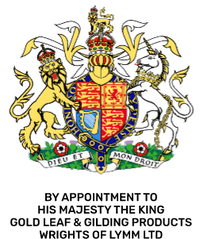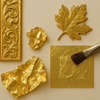Gold Leaf Across the World - Saudi Arabia
- by Sam Wozniak
The History and Uses of Gold Leaf Across Saudi Arabia
The story of gold leaf in Saudi Arabia is one of elegance, craftsmanship, and cultural continuity. For centuries, gold has symbolized wealth, spirituality, and divine beauty in the Arabian Peninsula. From the gilded manuscripts of early Islamic scholars to the monumental mosques, palaces, and modern architecture that now define the Kingdom’s skyline, goldleaf continues to embody refinement and prestige. Whether in the pure brilliance of 24 carat gold or the slightly more resilient 23.5 carat variant, gold leaf remains an integral part of Saudi artistic heritage and innovation.
In this post, we’ll explore how gold leaf arrived in the region, how it evolved through history, and how its uses continue to expand in contemporary Saudi Arabia — in art, architecture, restoration, and design.
Origins of Gold Leaf in the Arabian Peninsula
Gold has held spiritual and material importance across the Arabian Peninsula since antiquity. Pre-Islamic Arabian tribes used gold jewellery and artifacts as symbols of status and trade power. But it was during the rise of early Islamic civilization, particularly from the 7th century onward, that the use of gilding—the process of applying thin sheets of gold leaf to surfaces—became a refined artistic technique.
In the early Islamic world, which included regions of what is now Saudi Arabia, goldleaf was used to embellish Qur’anic manuscripts, architecture, and ceremonial objects. Early artisans perfected techniques for adhering 23.5 carat and 24 carat gold leaf to parchment, metal, and plaster. Gold leaf served not only as a mark of luxury but as a spiritual medium — a way to honor the sacred texts and spaces of Islam. In this way, gilding became closely associated with divine beauty and purity, concepts deeply rooted in Islamic aesthetics.
Gilding in Islamic Art and Architecture
As Islam spread across the Arabian Peninsula and beyond, gilding evolved into a sophisticated form of artistic expression. In Saudi Arabia’s historical regions — particularly in Hejaz, home to the holy cities of Makkah and Madinah — gold leaf adorned the interiors of mosques, religious manuscripts, and ceremonial artifacts.
In early mosque decoration, gold leaf was used to accent calligraphic inscriptions of Qur’anic verses and geometric motifs. The brilliance of gold complemented the spiritual symbolism of light in Islamic art, representing divine guidance and illumination. Artisans often employed 23.5 carat goldleaf for architectural gilding because it offered a perfect balance of lustre and durability, essential for the hot desert climate.
During the Ottoman period, gilding became even more prevalent across the Arabian Peninsula. Ottoman artisans and local craftsmen collaborated to embellish domes, mihrabs, and wooden minbars (pulpits) with delicate goldleaf detailing. The technique of water gilding — applying gold leaf over a prepared base of gesso and clay — was commonly used to achieve a luminous, long-lasting finish.
Gold Leaf in Monumental Saudi Architecture
In modern Saudi Arabia, the use of gold leaf has taken on new monumental proportions. The Kingdom’s architectural vision combines Islamic tradition with contemporary design, and gilding has become a key element in creating structures that reflect both heritage and innovation.
One of the most striking examples of goldleaf use in monumental architecture can be found in the Prophet’s Mosque (Al-Masjid an-Nabawi) in Madinah. The mosque’s ornate calligraphy, doors, and decorative elements feature real 24 carat gold leaf, applied through meticulous gilding techniques by master craftsmen. The golden details not only highlight the sacredness of the site but also demonstrate the continuing legacy of traditional artistry in modern religious architecture.
Similarly, the Kaaba’s Kiswa—the black silk covering draped over Islam’s holiest shrine in Makkah—features Qur’anic inscriptions embroidered in pure 24 carat gold thread, a contemporary expression of the same aesthetic and spiritual principles that have guided goldleaf craftsmanship for centuries.
In newer monumental projects, such as luxury hotels, royal palaces, and government buildings, gold leaf is increasingly used to convey prestige and timeless elegance. Designers often choose 23.5 carat goldleaf for interior elements such as domes, chandeliers, ceiling mouldings, and calligraphic panels, ensuring both brilliance and resilience in Saudi Arabia’s climate.
The Role of Gold Leaf in Art and Cultural Identity
Gold leaf has also become a popular medium in Saudi Arabia’s expanding contemporary art scene. As the Kingdom embraces cultural development through initiatives like Vision 2030, local artists have been experimenting with goldleaf to express identity, heritage, and spirituality in modern contexts.
Contemporary Saudi artists incorporate gold leaf into paintings, sculptures, and mixed-media works, often combining traditional Islamic motifs with abstract or conceptual themes. The use of 24 carat goldleaf in these artworks creates a bridge between past and present — merging ancient craftsmanship with modern creativity. For many artists, gold serves as both material and metaphor, symbolizing purity, enlightenment, and the enduring power of cultural memory.
This artistic revival mirrors a broader global trend: the re-emergence of gilding in fine art, interior design, and cultural preservation. In Saudi Arabia, however, this movement carries particular resonance, reflecting the Kingdom’s deep respect for its Islamic artistic heritage.
Gold Leaf in Restoration and Cultural Preservation
Beyond new creations, gold leaf plays a crucial role in the restoration and preservation of Saudi Arabia’s historical monuments. The Kingdom’s growing commitment to safeguarding cultural heritage has led to numerous restoration projects in mosques, palaces, and historic buildings — many of which involve meticulous gilding work.
Restoration specialists often rely on 23.5 carat gold leaf, prized for its durability and visual warmth, to recreate or repair original decorative elements. Using traditional methods such as oil and water gilding, restorers carefully match the tone, texture, and brilliance of historical goldwork. These efforts ensure that the splendour of Saudi Arabia’s architectural heritage endures for future generations.
Notable restoration initiatives include the renewal of historic mosques in Makkah and Madinah, as well as cultural preservation projects in Diriyah, the birthplace of the Saudi state. The Diriyah Gate Development, part of Vision 2030, integrates gilded design elements inspired by traditional Najdi architecture — blending contemporary design with ancient motifs to celebrate the Kingdom’s origins.
Modern Applications: Luxury Design and Interior Gilding
Today, gold leaf continues to define luxury in Saudi Arabia’s design and interior decoration sectors. Architects and interior designers frequently use goldleaf to add sophistication to modern spaces, whether through accent walls, ornate ceilings, or bespoke furniture finishes.
High-end hotels, royal residences, and mosques often feature 24 carat gold leaf embellishments in their interior décor. These applications not only enhance visual appeal but also convey cultural symbolism. Gold, in Islamic and Arab culture, represents light, paradise, and divine presence — qualities that make it an enduring choice in both traditional and contemporary settings.
Meanwhile, private artisans and boutique design studios across Riyadh and Jeddah specialize in goldleaf decoration for bespoke interiors. These craftspeople combine traditional hand-gilding techniques with modern materials, creating a fusion of heritage and innovation.
Conclusion: A Living Tradition of Gold and Glory
From the illuminated manuscripts of early Islamic scholars to the monumental architecture of modern Saudi Arabia, gold leaf has remained a constant symbol of reverence, prestige, and artistry. Whether in the pure radiance of 24 carat goldleaf or the balanced sheen of 23.5 carat gilding, its use continues to connect the Kingdom’s glorious past with its visionary present.
In Saudi Arabia today, gold leaf is not merely a decorative technique — it is a cultural language. It adorns mosques that inspire awe, restores monuments that preserve identity, and enriches artworks that define a new generation of Saudi creativity. Through ongoing innovation, restoration, and artistic exploration, the Kingdom continues to shine — not only as a centre of faith and progress but also as a beacon of timeless beauty, gilded in gold.






